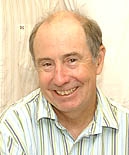Oct. 27, 2000

This is the 59th annual presentation of the honor, which recognizes exceptional research contributions of a campus faculty member. Traditionally, the recipient presents a springtime campus lecture related to his or her research.
Hammock, who was elected last year to the National Academy of Sciences, investigates new biological pest controls and analytical methods for detecting environmental contaminants.
"Bruce Hammock has had an outstanding research career," said George Bruening, acting chair of the Academic Senate's Faculty Research Lecture selection committee. "His research efforts have had an unusually broad impact on many different areas of biology, agriculture and medicine."
A member of the UC Davis faculty since 1980, Hammock has studied basic questions of biology and biochemistry that have practical implications for improving human and environmental health.
His current work is focused on three areas: finding improved pest-control agents; determining the human-health effects of pesticides, food additives and drugs; and developing rapid analytical methods for detecting environmental and food contaminants.
In the area of pest controls, Hammock has been studying natural agents, such as viruses, that can act as pesticides. He and colleagues have genetically engineered insect-specific viruses so that the viruses would interfere with the growth and development of certain caterpillars that feed on agricultural crops.
In research related to human health, Hammock studies "xenobiotics"-potentially harmful synthetic or naturally occurring chemicals to which people are exposed-including pesticides and drugs.
Intent on developing methods that will accurately predict the toxic risk of human exposure to these chemicals, Hammock's laboratory is examining various enzymes in the liver that are important in breaking down the chemicals to eliminate their toxicity. The researchers have worked to better understand how these liver enzymes work so that their activity can eventually be changed to make improved pharmaceuticals.
In his third area of research, Hammock has done pioneering work in using "immunochemical" methods to detect pesticides, food contaminants and industrial compounds in food, the environment and humans. The technology has been approved for use in the United States and Europe and is being used in developing countries to improve their food supplies.
Hammock, 53, is a native of Little Rock, Ark. He earned a bachelor's degree in entomology from Louisiana State University in 1969 and a doctoral degree in en-
tomology/toxicology at UC Berkeley in 1973, and was a Rockefeller Postdoctoral Fellow at Northwestern University. He worked at UC Riverside for six years before coming to UC Davis.
In addition to his research, Hammock teaches, mentors students and works with visiting scholars. Away from the laboratory, he enjoys rock climbing and kayaking.
He was elected in 1999 to the National Academy of Sciences, one of the highest honors for scientists in the United States. He has received numerous other academic awards including the prestigious Alexander von Humboldt Award in 1995 for his research contributions to U.S. agriculture and the $250,000 Burroughs Wellcome Toxicology Scholar Award from the Society of Toxicology in 1987.
The Faculty Research Lecturer award was established in 1941 by the Davis Sigma Chi club and is given annually to a faculty member whose research contributions have greatly enhanced human knowledge and brought widespread honor and recognition to themselves and the university. In 1951, the UC Davis Academic Senate, composed of ladder-rank faculty members, assumed responsibility for the award.
The most recent recipients of the award have been poet Gary Snyder, plant pathologist George Bruening, Spanish literature scholar Samuel Armistead, political scientist Donald Rothchild, author and English professor Sandra Gilbert and animal behaviorist Peter Marler.—UC Davis News Service
--Kathy Keatley Garvey
Communications specialist
UC Davis Department of Entomology
(530) 754-6894